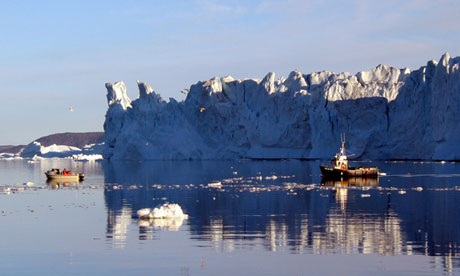China pours cash into melting Arctic in bid to win influence
China's growing economy needs minerals and oil – and its gaze is increasingly focused northwards

An iceberg off the
west coast of Greenland, which is considering a $2.3bn mining project
which would supply China with 15m tonnes of iron ore a year. Photograph:
Slim Allagui/AFP/Getty Images
But diplomatic relations are thawing as quickly as Arctic ice – and the upshot could be significant for the frigid northern wastes of the planet, which are thought to sit on formidable quantities of mineral reserves.
China has been cosying up to Arctic countries as part of its effort to secure "permanent observer" status on the Arctic Council, an eight-country political body that decides regional policy. Norway was initially sniffy at the approaches because of the Nobel row, but appears to have changed its tune before a formal decision in May.
Last week, the Norwegian foreign minister, Espen Barth Eide, told reporters in Oslo that he strongly supported China's application.
The "argument for opening up for more observers in the Arctic Council is that they will then be a member of our club," he said, according to Norwegian media. "Then the danger of them forming their own club will be smaller."
"There are not many areas where Norway is important to China at all, but the Arctic is one of them," said Leiv Lunde, director of the Fridtjof Nansen Institute in Lysaker, Norway. China, he added, was beginning to realise that its diplomatic boycott "is not good PR in sort of bolstering the positive image that China wants to bolster as an Arctic player".
Currently, 80% of China's imported energy passes through the Strait of Malacca – a crowded, heavily pirated waterway that squeezes past Singapore. Yet over the past few years, melting Arctic ice, a casualty of climate change, has turned the frigid north into a viable shipping route. The newly navigable northern sea route above Russia would cut the distance between Shanghai and northern Europe by 4,000 miles, saving medium-sized bulk carriers about two weeks and £260,000 on each journey. Three years ago, no ships made the voyage. Last year, there were 46.
Last August, Chinese scientists aboard a Ukrainian-built icebreaker, the Xuelong, or Snow Dragon, completed the country's first trans-Arctic ship voyage from Shanghai to Iceland. The trip's leader, Huigen Yang, told Reuters this week that Chinese shipping companies, encouraged by the ship's success, may be planning a commercial voyage along the same route as soon as this summer.
Scandinavian shipping companies – long an influential force in the region's politics – are also ebullient about the development. "For the producers up north, all of a sudden they have a two-tier market to play on," said Henrik Falck, a project manager at Norway's Tschudi Shipping Company. "They can either ship their cargo to China or the far east, or they can send it to the continent as they are doing today. And the transportation cost is no longer killing the deal."
Although China has never announced an official Arctic policy, some fear that its regional economic interests could have military implications. Furthermore, the US Geological Survey estimates that 30% of the world's undiscovered natural gas reserves lie above the Arctic Circle, in addition to vast deposits of oil, coal, rare earths and uranium, and experts say that China wants to get in on the ground floor.
"The way I see it, very minor investments for China now can warrant very big rewards in the future," said Malte Humpert, founder and executive director of the Arctic Institute in Washington DC. "It's a low risk and obvious choice."
One indicator is China's recent interest in Greenland. The vast, self-governing country's parliament is considering approving a $2.3bn (£1.5bn) mining project north-east of the capital, Nuuk, which would be led by the UK-based London Mining plc but supply China with 15m tonnes of iron ore a year.
The project, which may kick off this summer, would require a team of 3,000 Chinese workers, adding more than 4% to the country's population of 57,000. Some fear that it would affect Greenland's pristine natural environment, which locals rely on for hunting and fishing.
Greenland's prime minister, Aleqa Hammond, who was elected last Tuesday, has promised to assuage these fears by limiting inflows of cheap labour from abroad.
"What could the creation of a mine and the arrival of some 3,000 Chinese workers mean to me as an inhabitant of a hamlet? What will it mean to me and my hunting grounds?" she told the Associated Press.
Tiny, 320,000-population Iceland may best represent the polarity of Europe's reactions to China's Arctic aspirations. Last year, Icelandic authorities rejected a Chinese billionaire's bid to turn land in the country's barren north into a holiday resort. Some said that the development's proximity to deepwater ports could pose security risks.
Yet former Chinese premier Wen Jiabao made Iceland his first stop on his European tour last spring, signing Arctic co-operation agreements with the Icelandic prime minister. China's $250m embassy in Iceland's capital, Reykjavik, can accommodate 500 personnel; in contrast the US embassy has a staff of 70.
When the Snow Dragon icebreaker docked at the port of Reykjavik last August, the country's president was standing there to welcome the ship

No comments:
Post a Comment
Comments always welcome!